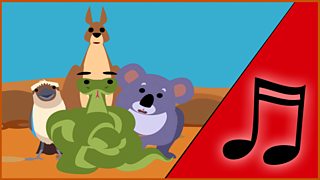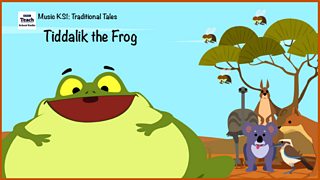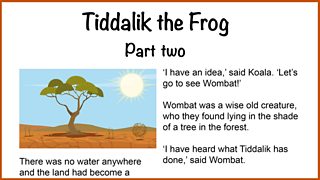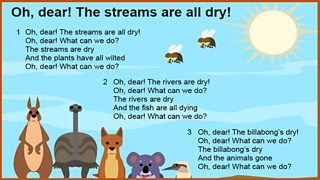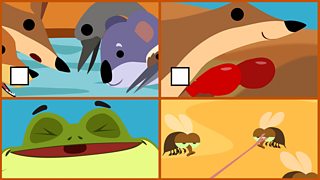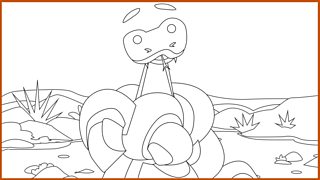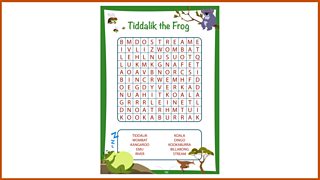Tiddalik the Frog. 2: Oh, dear! The streams are all dry!
In the second part of Tiddalik the Frog the thirsty animals visit the wise Wombat. He tells them to stage a Funny Show for Tiddalik: if they can make the frog laugh all the water might come out of his belly. The song contrasts bouncy and smooth phrases, while the music activity focuses on clapping with the beat and then with the off-beat.
Tutorial: Learn the song 'Oh, dear! The streams are all dry!'
Join Andy and Rebecca to learn the song.
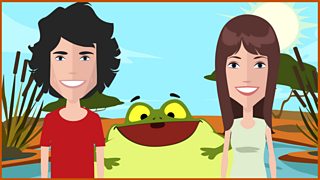
The main elements of the tutorial are:
- Identifying that the first two lines of each verse have short, bouncy notes (the musical term for this is staccato). The music here has a tense, worried feel - reflecting how anxious the thirsty animals are.
- Identifying how the third line of each verse is slow and smooth (legato) reflecting how sad the thirsty animals are that all the water has been drunk by Tiddalik.
- Paying attention to keeping in time as the music changes tempo.
- Identifying how the key changes from minor to major in the coda to give the song a bright, happy ending.
Duration: 08 21
Story: Tiddalik the Frog, Part 2
Tiddalik the Frog has drunk all the water in the world. The animals devise a plan to get the water out of his belly. They hold a ‘Funny Show’ for him and when Snake accidentally ties herself in a knot Tiddalik finds it hilarious! He laughs and the water comes out of his tummy and returns to the streams, rivers and billabongs.
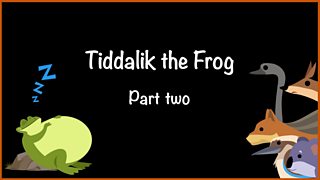
Story questions:
- Ask the children if they can remember what has happened so far in the story.
- Which wise creature do the thirsty animals go to see? (Wombat).
- Which three of the thirsty animals perform at the Funny Show and what do they do? (Kookaburra - jokes; Kangaroo - boxing match; Koala - pulls faces).
- What is the surprise final performance at the Funny Show? (Snake dancing).
Duration: 05 47
Song: 'Oh, dear! The streams are all dry!'
Sing the song with Andy and Rebecca. The clips carousel begins with the full-vocal version of the song and is followed by individual clips for Verse 1, Verse 2, Verse 3, the Coda and ends with the backing track version of the song. This allows you to navigate quickly to the individual sections of the song and to focus on specific sections while learning it.
for the Lyrics. for the Music.
Music activity
Focus: Pulse - the main beat / Clapping in time with the beat / Clapping with the off-beat

- Discuss how a pulse - or main steady beat - usually runs through a piece of music. This is what helps to 'hold the music together'.
- Andy and Rebecca clap the pulse and the children copy.
- Discuss how an off-beat is a beat which comes after the main beat. Andy and Rebecca clap the off-beat and the children copy.
- Children divide into two groups: A and B. They practise clapping on and off the beat with the presenters.
- Discuss if it was easy to stay in time? What special skills did the children need - eg watching everyone else, focusing and listening carefully.
- Working in pairs and singing or using percussion instruments, the children can make up some of their own on or off the beat pieces.
Duration: 05 32
Listening music: Grieg - 'In the hall of the Mountain King' from 'Peer Gynt'
This music was written in 1875 by Edvard Grieg and it's about a young man called Peer Gynt who is wandering in the mountains when he is captured by trolls. He runs away and the trolls chase him.
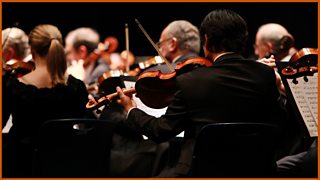
- What is the group of instruments that is playing called? (An orchestra). Do the children know some of the families of the orchestra? (String, woodwind, brass and percussion families). Look at some pictures of the different families of the orchestra.
- The instruments are playing staccato. Refer this to the song, which also has staccato sections.
- As the music continues can the children hear when the orchestra plays more smoothly or legato? This is towards the end of the piece, when the music gets faster.
- What are the dynamics of the music? (It starts off quietly and gradually gets louder).
- Tempo: what happens as the music continues? (It starts off slowly, but gradually gets faster).
- What do the children imagine as they listen to this music? If they imagine the trolls, what do they think they are doing as the music gets faster?
Duration: 01 58
Resources
-
![]()
Guidance on all the content (pdf)
-
![]()
Download / print the illustrated transcript of Episode 2 (pdf)
-
![]()
Download / print the lyrics for 'Oh, dear! The streams are all dry!' (pdf)
-
![]()
Download / print the music for 'Oh, dear! The streams are all dry!' (pdf)
-
![]()
Sequence the events of the story (pdf)
-
![]()
Download / print Snake to colour in (pdf)
-
![]()
Download / print the word search puzzle (pdf)
-
![]()
Download / print the vocab sheet (pdf)
-
![]()
Download / print the writing sheet (pdf)

